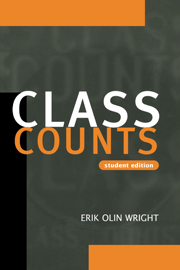Book contents
- Frontmatter
- Contents
- Preface to student edition
- Preface to original edition
- Acknowledgments
- 1 Class analysis
- Part I Structural analyses of classes
- Part II Class and gender
- 6 Conceptualizing the interaction of class and gender
- 7 Individuals, families and class analysis
- 8 The noneffects of class on the gendered division of labor in the home
- 9 The gender gap in workplace authority
- Part III Class structure and class consciousness
- Part IV Conclusion
- References
- Index
- Index of subjects
8 - The noneffects of class on the gendered division of labor in the home
Published online by Cambridge University Press: 22 September 2009
- Frontmatter
- Contents
- Preface to student edition
- Preface to original edition
- Acknowledgments
- 1 Class analysis
- Part I Structural analyses of classes
- Part II Class and gender
- 6 Conceptualizing the interaction of class and gender
- 7 Individuals, families and class analysis
- 8 The noneffects of class on the gendered division of labor in the home
- 9 The gender gap in workplace authority
- Part III Class structure and class consciousness
- Part IV Conclusion
- References
- Index
- Index of subjects
Summary
The central objective of this chapter is to explore systematically the empirical relationship between the location of households in the class structure and gender inequalities in performance of housework. Since the middle of the 1970s, class analysts interested in gender, particularly those rooted in the Marxist tradition, have placed domestic labor at the center of analysis. In a variety of different ways, they have argued that the linkage between the system of production, analyzed in class terms, and the domestic division of labor, analyzed in gender terms, was at the heart of understanding the social processes through which gender relations were themselves reproduced (or perhaps even generated) in capitalist societies. Sometimes this argument took a rather reductionist form, particularly when the performance of unpaid domestic labor by women in the home was explained by the functional requirements of capital accumulation. In other cases, the argument was less reductionist, emphasizing the nature of the class-generated constraints imposed on strategies of men and women as they negotiated gender relations within the household rather than the functional fit between capitalism and patriarchy. And, in still other analyses, the possibilities of systematic contradictions between the logics of capitalist class domination and patriarchal male domination were entertained. In all of these analyses, in spite of the differences in theoretical argument, the role of domestic labor in the linkage between class relations and gender relations was a central theme.
- Type
- Chapter
- Information
- Class Counts , pp. 146 - 158Publisher: Cambridge University PressPrint publication year: 2000



